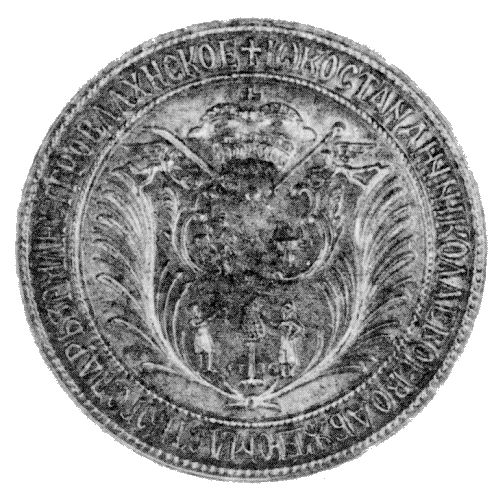|
Constantine Mavrocordato
Constantine Mavrocordatos (Greek: Κωνσταντίνος Μαυροκορδάτος, Romanian: ''Constantin Mavrocordat''; February 27, 1711November 23, 1769) was a Greek noble who served as Prince of Wallachia and Prince of Moldavia at several intervals between 1730 and 1769. As a ruler he issued reforms in the laws of each of the two Danubian Principalities, ensuring a more adequate taxation and a series of measures amounting to the emancipation of serfs and a more humane treatment of slaves. Life First rules Born in Constantinople (now Istanbul) as a Phanariote member of the Mavrocordatos family, Constantine succeeded his father, Nicholas Mavrocordatos, as Prince of Wallachia in 1730, after obtaining boyar support. He was deprived in the same year, but again ruled the principality five more times from 1731 to 1733, from 1735 to 1741, from 1744 to 1748, from 1756 and 1758 and from 1761 to 1763. He managed to regain control over Oltenia (the Banat of Craiova) through the Treaty ... [...More Info...] [...Related Items...] OR: [Wikipedia] [Google] [Baidu] |
Prince
A prince is a male ruler (ranked below a king, grand prince, and grand duke) or a male member of a monarch's or former monarch's family. ''Prince'' is also a title of nobility (often highest), often hereditary, in some European states. The female equivalent is a princess. The English word derives, via the French word ''prince'', from the Latin noun , from (first) and (head), meaning "the first, foremost, the chief, most distinguished, noble ruler, prince". In a related sense, now not commonly used, all more or less sovereign rulers over a state, including kings, were "princes" in the language of international politics. They normally had another title, for example king or duke. Many of these were Princes of the Holy Roman Empire. Historical background The Latin word (older Latin *prīsmo-kaps, ), became the usual title of the informal leader of the Roman senate some centuries before the transition to empire, the '' princeps senatus''. Emperor Augustus establishe ... [...More Info...] [...Related Items...] OR: [Wikipedia] [Google] [Baidu] |
Ottoman Empire
The Ottoman Empire (), also called the Turkish Empire, was an empire, imperial realm that controlled much of Southeast Europe, West Asia, and North Africa from the 14th to early 20th centuries; it also controlled parts of southeastern Central Europe, between the early 16th and early 18th centuries. The empire emerged from a Anatolian beyliks, ''beylik'', or principality, founded in northwestern Anatolia in by the Turkoman (ethnonym), Turkoman tribal leader Osman I. His successors Ottoman wars in Europe, conquered much of Anatolia and expanded into the Balkans by the mid-14th century, transforming their petty kingdom into a transcontinental empire. The Ottomans ended the Byzantine Empire with the Fall of Constantinople, conquest of Constantinople in 1453 by Mehmed II. With its capital at History of Istanbul#Ottoman Empire, Constantinople (modern-day Istanbul) and control over a significant portion of the Mediterranean Basin, the Ottoman Empire was at the centre of interacti ... [...More Info...] [...Related Items...] OR: [Wikipedia] [Google] [Baidu] |
Treaty Of Belgrade
The Treaty of Belgrade, also known as the Belgrade Peace, was a peace treaty between the Habsburg Monarchy and Ottoman Empire, that was signed on September 18, 1739 in Belgrade (modern Serbia), thus ending the Austro–Turkish War (1737–1739). Agreed territorial changes were substantial, and also favorable for the Ottoman side, since Habsburgs had to cede three regions: the Banat of Craiova (modern Oltenia), the Kingdom of Serbia with Belgrade, and Bosnian section of Posavina, thus placing the newly defined Habsburg-Ottoman border on the rivers Sava and Danube. Negotiations During the final stages of the Austro-Turkish War (1737–1739), the main Habsburg army, commanded by field marshal Wallis suffered a strategic defeat at the Battle of Grocka (21–22 July, 1739), and retreated into the Belgrade Fortress, that was soon besieged by the Ottoman forces. Already on 31 July, the government in Vienna decided to relieve Wallis of his previously granted powers to negoti ... [...More Info...] [...Related Items...] OR: [Wikipedia] [Google] [Baidu] |
Banat Of Craiova
The Banat of Craiova or Banat of Krajowa (; ), also known as Cisalutanian Wallachian Principality () and Imperial Wallachia (German: ''Kaiserliche Walachei''; Latin: ''Caesarea Wallachia''; Romanian: ''Chesariceasca Valahie''), was a Romanian-inhabited province of the Habsburg monarchy. It emerged from the western third of Wallachia, now commonly known as Oltenia, which the Habsburgs took in a preceding war with the Ottoman Empire—in tandem with the Banat of Temeswar and Serbia. It was a legal successor to the Great Banship of Craiova, with the Wallachian as its native leader, or '' Ban''. Over the following years, native rule was phased out, and gave way to a direct administration. This provided the setting for Germanization of the bureaucratic elite, introducing the governing methods of enlightened absolutism and colonialism. Habsburg rule over Oltenia only lasted two decades, which fit within the reign of just one Austrian Emperor (and titular "Prince of Cisalutanian Wal ... [...More Info...] [...Related Items...] OR: [Wikipedia] [Google] [Baidu] |


